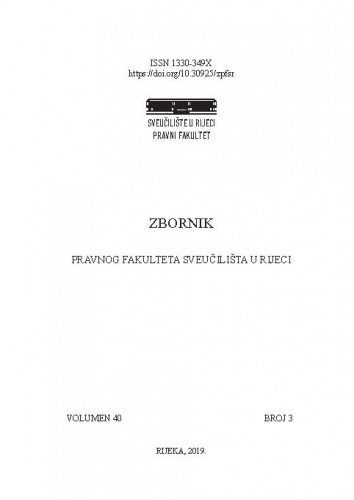Granični spor između Lovrana i Mošćenica iz 1646. godine poznat je u literaturi, dok je arhivski izvor u kojemu je zabilježen paleografski i filološki odgovarajuće obrađen i vrednovan. Premda je riječ o pravnom aktu, njegova je pravna odrednica nepoznata, što se posebno odnosi na nekoliko instituta, pojmova i izričaja koji svojom preciznošću, određenošću i pravnotehničkom izraženošću odudaraju od mjesnih feudalnih običajnih pravnih shvaćanja toga vremena. K tome, premda su ti pojmovi te izričaji u ispravi dokumentirani na talijanskome, oni su prigodno talijanizirani, a zapravo pripadaju latinskom jeziku. Dodatno, kada se spominju, oni odstupaju od uobičajene srednjovjekovne deskriptivnosti pravnoga jezika i administrativno-funkcionalnog stila kojima obiluje tadašnja pravna diplomatika. Kako sve navedene naznake upućuju na mogućnost da su ključni pojmovi, izričaji i instituti u lovransko-mošćeničkom razgraničenju preuzeti iz rimske pravne tradicije koja je na ovo područje prodirala i posredstvom ius commune te dijelom iz rimsko-kanonskoga procesa, u radu se propituje njihovo pravno podrijetlo te uloga i svrha koja se njihovim korištenjem postizala u konkretnom razgraničenju. U radu se posebna pažnja posvećuje procesnom mehanizmu kojim je riješen granični spor između Lovrana i Mošćenica te mogućnosti da je on oblikovan po uzoru na rimsku arbitražu i donekle na rimsko-kanonski proces.; The boundary dispute between Lovran and Mošćenice of 1646 quite recently received some attention in the literature and was simultaneously adequately elaborated form palaeographic and philological point of view. Despite the fact that it is substantially a legal act, its legal content did not receive adequate attention of the scholars, which may primarily be said with reference to its institutes, terms and expressions whose precision, accuracy and legal technical at first sight most evidently depart from the local feudal legal customs and legal traditions. Moreover, nevertheless that these terms and expressions were written down in Italian language of the time, they evidently represent Italianized version of terms, expression and legal concepts that originally belong to Latin language. Additionally, their mentions in the document at hand have no resemblance to the usual medieval descriptions of the legal phenomena which have a little in common with normative language or to administrativefunctional style of that time which distinctively shaped the legal documents. Because all these indications suggest that the key terms, expressions and institutes pertinent to the boundary dispute between Lovran and Mošćenice (and its resolution) might be borrowed from the Roman legal tradition (which outreached this territory by means of ius commune) and the Romano-canonical process, this paper examines origin, roles and functions which were achieved in practice by their use in this particular legal matter. The paper will specifically explore the procedural mechanism which was employed to reach settlement of the boundary dispute between Lovran and Mošćenice and will additionally provide a deeper insight into the possibility that in this particular case arbitration conceptually based on the Roman law was employed as the means of dispute resolution.; Die Grenzstreitigkeit zwischen Lovran und Mošćenice aus dem Jahr 1646 erfuhr Aufmerksamkeit in der Literatur und wurde auch aus paläographischer und philologischer Sicht untersucht. Obwohl es sich hier um einen Rechtsakt handelt, ist seine rechtliche Bestimmung unbekannt, was insbesondere für einige Rechtsfiguren, Begriffe und Ausdrücke gilt, wessen Genauigkeit, Richtigkeit und rechtstechnische Grundlagen von den örtlichen feudalen und rechtlichen Traditionen dieser Zeit abweichen. Obwohl diese Begriffe in italienischer Sprache dokumentiert wurden, wurden sie eigentlich aus dem Latein übernommen. Diese Begriffe weichen auch von der mittelalterlichen Deskriptivität der Rechtsprache und des administrativfunktionellen Stils der damaligen Rechtsdiplomatik ab. Da alles darauf hinweist, dass die Schlüsselbegriffe und Rechtsfiguren im Kontext der Grenzstreitigkeit zwischen Lovran und Mošćenice aus der römischen Rechtstradition übernommen wurden, die auf dieses Gebiet durch ius commune und teilweise aus dem römischen Kirchenrecht Einfluss übte, werden in diesem Beitrag ihre rechtliche Etymologie und Rolle bei der Benutzung in der genannten Grenzstreitigkeit überprüft. Besondere Aufmerksamkeit schenkt man in diesem Beitrag dem Prozessmechanismus, durch welchen die Grenzstreitigkeit zwischen Lovran und Mošćenice beigelegt wurde. Ebenfalls wird betont, dass es möglich ist, dass die Streitigkeit das römische Schiedsverfahren und teilweise das römische kanonische Prozess als Vorbild hatte.; La lite sui confini tra Laurana e Moschiena del 1646 è nota nella letteratura: altresì, la fonte d’archivio nella quale è annotata è curata e valutata correttamente da un punto di vista paleografico e filologico. Benché si tratti di un atto giuridico, la sua natura giuridica è sconosciuta: ciò si riferisce soprattutto ad alcuni istituti, nozioni ed espressioni che con la loro precisione, determinazione ed accuratezza giuridica paiono subito sono in contrasto con le usanze feudali giuridiche locali del tempo. In aggiunta, benché tali nozioni ed espressioni nell’atto siano documentate in lingua italiana, è di tutta evidenza come essi siano la versione italianizzata di termini latini. Ancora, quando si menzionano tali nozioni ed espressioni si differenziano rispetto alla comune descrizione del linguaggio giuridico medievale e rispetto allo stile amministrativofunzionale di cui abbondava la diplomazia giuridica del tempo. Posto che tutto indirizza alla possibilità che le nozioni, le espressioni e gli istituti nell’accertamento dei confini tra Laurana e Moschiena vennero tratti dalla tradizione giuridica romana, che si fece strada in questo territorio anche attraverso lo ius commune ed in parte mediante il processo romano-canonico, nel presente contributo si indaga circa la loro provenienza giuridica ed il loro ruolo e scopo che mediante il loro utilizzo venne raggiunto nella lite sui confini. Nel lavoro si presta particolare attenzione al meccanismo processuale con il quale venne risolta la lite tra Laurana e Moschiena, come particolare attenzione viene prestata alla possibilità che lo stesso fosse stato basato sul modello dell’arbitrato romano ed in parte sul processo romano-canonico.
Sažetak

 Zbornik Pravnog fakulteta Sveučilišta u Rijeci : 40,3(2019) / glavni urednik Željko Bartulović.
Zbornik Pravnog fakulteta Sveučilišta u Rijeci : 40,3(2019) / glavni urednik Željko Bartulović.